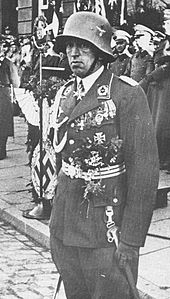Theodor Osterkamp

Theodor Osterkamp (born April 15, 1892 in Rölsdorf , † January 2, 1975 in Baden-Baden ) was a successful fighter pilot in the First World War in the Imperial Navy and in the Second World War Lieutenant General of the Wehrmacht Air Force . Osterkamp, who was friends with Manfred von Richthofen , achieved 32 aerial victories in the First World War. During the Second World War he fought as a commodore of Jagdgeschwader 51 in the Battle of Britain , where he won another six victories.
Life
Osterkamp was born the son of a factory owner in Aschersleben and attended high school in Dessau . His schoolmates included the later pilots Oswald Boelcke and Gotthard Sachsenberg . Later he studied forestry in Düren . At the time he lived in Rölsdorf .
Osterkamp joined the Naval Aviation Corps on August 14, 1914 during the First World War, where he was initially employed as an observer and then as a pilot in the 2nd Naval Aviation Department in the Flanders Battles of 1915/16. He was the first pilot in 1917 to pilot a land plane for a reconnaissance mission to Great Britain . In 1917 he was trained as a fighter pilot with the naval aviators in Putzig and transferred to Sachsenberg's naval fighter squadron 1. In March 1917 he made flight attempts with the Junkers J 7 . Promoted to lieutenant in the reserve sea in June , Osterkamp took over the command of the Navy Fighter Squadron 2 on October 15, 1917. As an experienced fighter pilot, he took part in comparative flights in Adlershof on July 11, 1918 and tested the Junkers J 7 and J 9 . Osterkamp scored 32 aerial victories and was awarded the Pour le Mérite order on September 2, 1918 . He had already received both classes of the Iron Cross and the Knight's Cross of the Royal House Order of Hohenzollern with Swords.
On February 14, 1919, Osterkamp became an honorary member of the Anhalt Aviation Association. In the same year he fought with other volunteers, including the fighter pilots Josef Jacobs and Gotthard Sachsenberg , as a pilot in the Kurland squadron against the Red Army . On January 21, 1920 Osterkamp was retired from military service.
From 1927 he worked as a station manager at the Kiel-Holtenau sea flight station of Luftdienst GmbH and in 1931 took over the same function at the Norderney sea flight station . Reactivated in 1933, Osterkamp took on a leading role in building up the new air force and, among other things, set up Fighter Pilot School 1 in Werneuchen near Berlin . He also took part in civil aviation competitions of the Fédération Aéronautique Internationale , where he came 11th in 1930, 12th in 1932 and 5th in 1934. In 1938 Osterkamp published an autobiography ( Du or Ich. German fighter pilots in ups and downs ).

On September 19, 1939, Colonel Osterkamp became a squadron commodore of the Jagdgeschwader (JG) 51 . During the campaign in the west , he achieved four aerial victories, the first on May 12, 1940. On August 22, 1940, he received the Knight's Cross of the Iron Cross . In the "canal battle " during the Battle of Britain he scored two more kills. In July 1940, after the handover of command of JG 51 to Werner Mölders , Osterkamp was promoted to major general and was then leader of the fighter pilots in Luftflotte 2 . On August 1, 1942, when he was promoted to Lieutenant General, he took over the Luftgaustab z. b. V. Africa and from April 5, 1943 until his replacement by Adolf Galland on June 15, was the fighter pilot in Sicily. After a number of other staff assignments, he was appointed inspector of the Luftwaffe ground organization in 1944. Osterkamp fell out with the Air Force High Command and was released on December 31, 1944.
He worked as a forester in Lower Saxony until 1945 , then as a businessman until his retirement in 1966. Osterkamp died on January 2, 1975.
See also
literature
- Hanns Möller: History of the knights of the order "pour le mérite" in the world war. Volume 2: M-Z. Bernard & Graefe publishing house. Berlin 1935. pp. 97-98.
- Karl-Friedrich Hildebrand, Christian Zweng: The knights of the order Pour le Mérite of the First World War. Volume 2: HO. Biblio Publishing House. Bissendorf 2003. ISBN 3-7648-2516-2 . Pp. 533-534.
Web links
- Literature by and about Theodor Osterkamp in the catalog of the German National Library
Individual evidence
- ↑ a b Veit Scherzer : Knight's Cross bearer 1939–1945. The holders of the Iron Cross of the Army, Air Force, Navy, Waffen-SS, Volkssturm and armed forces allied with Germany according to the documents of the Federal Archives. 2nd Edition. Scherzers Militaer-Verlag, Ranis / Jena 2007, ISBN 978-3-938845-17-2 , p. 579.
- ↑ Marine Officer Association (ed.): Honor ranking list of the Imperial German Navy. 1914-18. Thormann & Goetsch. Berlin 1935. p. 960.
| personal data | |
|---|---|
| SURNAME | Osterkamp, Theodor |
| ALTERNATIVE NAMES | Osterkamp, Theo |
| BRIEF DESCRIPTION | German officer, most recently major general in World War II |
| DATE OF BIRTH | April 15, 1892 |
| PLACE OF BIRTH | Rölsdorf |
| DATE OF DEATH | 2nd January 1975 |
| Place of death | Baden-Baden |


